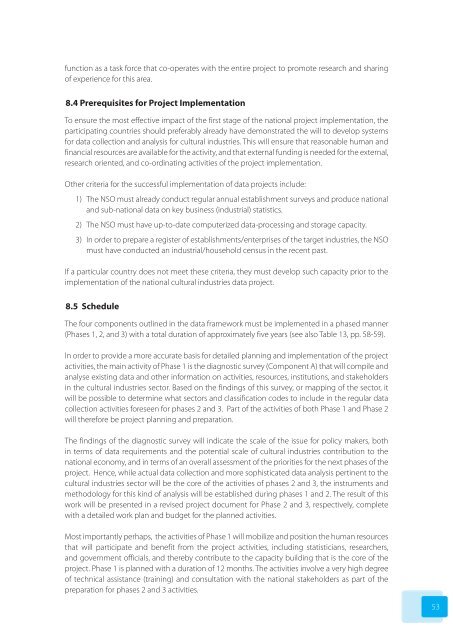Statistics on Cultural Industries - International Trade Centre
Statistics on Cultural Industries - International Trade Centre
Statistics on Cultural Industries - International Trade Centre
- No tags were found...
Create successful ePaper yourself
Turn your PDF publications into a flip-book with our unique Google optimized e-Paper software.
functi<strong>on</strong> as a task force that co-operates with the entire project to promote research and sharingof experience for this area.8.4 Prerequisites for Project Implementati<strong>on</strong>To ensure the most effective impact of the first stage of the nati<strong>on</strong>al project implementati<strong>on</strong>, theparticipating countries should preferably already have dem<strong>on</strong>strated the will to develop systemsfor data collecti<strong>on</strong> and analysis for cultural industries. This will ensure that reas<strong>on</strong>able human andfinancial resources are available for the activity, and that external funding is needed for the external,research oriented, and co-ordinating activities of the project implementati<strong>on</strong>.Other criteria for the successful implementati<strong>on</strong> of data projects include:1)2)3)The NSO must already c<strong>on</strong>duct regular annual establishment surveys and produce nati<strong>on</strong>aland sub-nati<strong>on</strong>al data <strong>on</strong> key business (industrial) statistics.The NSO must have up-to-date computerized data-processing and storage capacity.In order to prepare a register of establishments/enterprises of the target industries, the NSOmust have c<strong>on</strong>ducted an industrial/household census in the recent past.If a particular country does not meet these criteria, they must develop such capacity prior to theimplementati<strong>on</strong> of the nati<strong>on</strong>al cultural industries data project.8.5 ScheduleThe four comp<strong>on</strong>ents outlined in the data framework must be implemented in a phased manner(Phases 1, 2, and 3) with a total durati<strong>on</strong> of approximately five years (see also Table 13, pp. 58-59).In order to provide a more accurate basis for detailed planning and implementati<strong>on</strong> of the projectactivities, the main activity of Phase 1 is the diagnostic survey (Comp<strong>on</strong>ent A) that will compile andanalyse existing data and other informati<strong>on</strong> <strong>on</strong> activities, resources, instituti<strong>on</strong>s, and stakeholdersin the cultural industries sector. Based <strong>on</strong> the findings of this survey, or mapping of the sector, itwill be possible to determine what sectors and classificati<strong>on</strong> codes to include in the regular datacollecti<strong>on</strong> activities foreseen for phases 2 and 3. Part of the activities of both Phase 1 and Phase 2will therefore be project planning and preparati<strong>on</strong>.The findings of the diagnostic survey will indicate the scale of the issue for policy makers, bothin terms of data requirements and the potential scale of cultural industries c<strong>on</strong>tributi<strong>on</strong> to thenati<strong>on</strong>al ec<strong>on</strong>omy, and in terms of an overall assessment of the priorities for the next phases of theproject. Hence, while actual data collecti<strong>on</strong> and more sophisticated data analysis pertinent to thecultural industries sector will be the core of the activities of phases 2 and 3, the instruments andmethodology for this kind of analysis will be established during phases 1 and 2. The result of thiswork will be presented in a revised project document for Phase 2 and 3, respectively, completewith a detailed work plan and budget for the planned activities.Most importantly perhaps, the activities of Phase 1 will mobilize and positi<strong>on</strong> the human resourcesthat will participate and benefit from the project activities, including statisticians, researchers,and government officials, and thereby c<strong>on</strong>tribute to the capacity building that is the core of theproject. Phase 1 is planned with a durati<strong>on</strong> of 12 m<strong>on</strong>ths. The activities involve a very high degreeof technical assistance (training) and c<strong>on</strong>sultati<strong>on</strong> with the nati<strong>on</strong>al stakeholders as part of thepreparati<strong>on</strong> for phases 2 and 3 activities.53
















